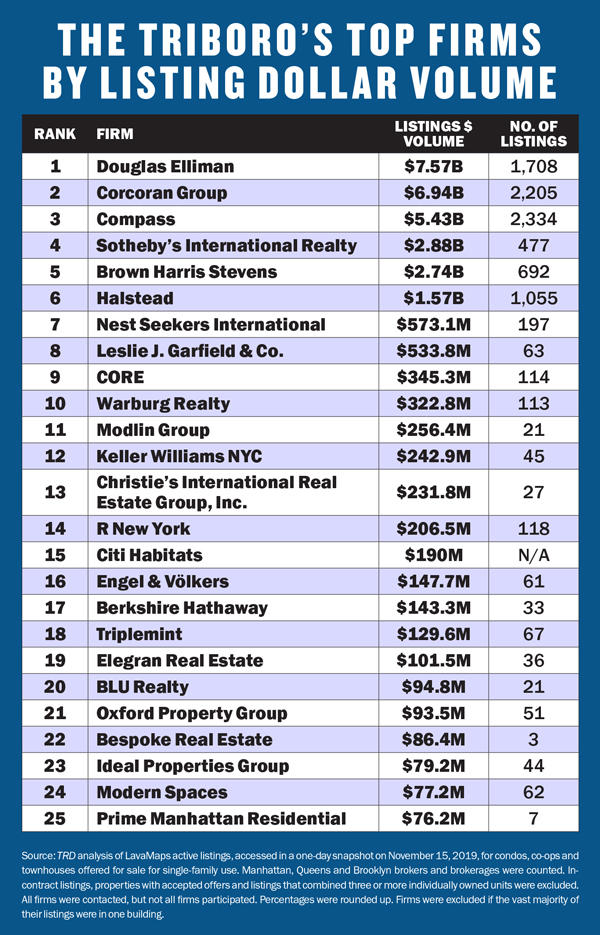It was the year of the buyer — with some of the priciest New York City sales counting as buy-side deals for major players like Corcoran, Compass and Douglas Elliman.
Among them were the 54 deals that closed at Vornado’s 220 Central Park South in 2019 for a total of $1.6 billion, ranging from a $238 million spread to a $55 million condo.
But it’s still a sell-side game for the biggest brokerages as many look to further expand their offerings. And listing volume remains one of the best ways to assess the strength of a firm’s pipeline of business.

“The better listing companies are the ones that tend to grow,” said Steve Murray of the national brokerage research company Real Trends. That applies to virtually any market across the country, he noted.
Applying that to the ever-puzzling New York market, The Real Deal expanded this year’s listings ranking beyond Manhattan into Brooklyn and Queens for the first time, getting a broader view of which firms are gaining market share in the city’s three most active boroughs for sales.
This year’s ranking was based on an analysis of on market listings captured in a 24-hour period on Nov. 15, 2019.
Elliman took the No. 1 spot with a total of $7.57 billion across 1,708 properties listed.
Related: TRD’s resi brokerage ranking expands beyond Manhattan
In recent weeks, Elliman’s Alexander Team recently listed a unit owned by wealthy Russian couple, Valergy and Olga Kogan, at 1 Central Park South for $45 million, while Roger Erickson put a four-bedroom at the Crown Building on the market asking nearly $60 million.
And while the vast majority of Elliman’s listings were in Manhattan, the firm had 253 in Brooklyn totaling $647 million and 34 in Queens totaling $24 million. The brokerage’s New York City president and CEO Steven James said, “I think there’s enough business to go around. … There’s a large enough pool of buyers.”
Corcoran followed close behind with a total dollar volume of $6.94 billion across 2,205 listings in the three boroughs and had the strongest showing in Brooklyn with the largest total dollar volume at $1.14 billion and the highest number of listings at 631.
In January, Corcoran broker Manju Jasty listed billionaire Richard Leibovitch’s unit at 220 Central Park South for $36 million.
“In difficult markets, sellers turn to the most experienced agents,” Corcoran CEO Pam Liebman said.
She recalled walking into one property previously listed by a well-known agent at another firm that Corcoran took over and finding old drapes hanging in the windows and a generally messy interior.
“I was shocked,” she said. “I wouldn’t go on a first date without any makeup or wearing sweatpants. That’s not how a property should be shown either.”
Compass took the No. 3 spot in dollar volume with $5.43 billion across 2,334 properties — the highest number of listings among all of the firms. But it also had the lowest average listing price among the leading firms at $2.3 million.
The bulk of the Softbank-backed brokerage’s listings were concentrated in Manhattan, but Compass closely trailed Corcoran in Brooklyn with 618 listings valued at $1.01 billion. And it nearly cracked $100 million for its 77 Queens properties on the market, making it the leading firm for listings in the borough.
“We’ve never looked at these markets as secondary or tertiary,” said Rory Golod, Compass’ head of the New York region. “We see an upside there.”

Sotheby’s International Realty, meanwhile, surged back into the top five listing brokerages at No. 4 with a total of $2.88 billion across 477 properties with an average listing price of $6 million.
Sotheby’s CEO Philip White said that’s on brand for the firm and pointed to Jeff Bezos’s $80 million purchase of three condo units at 212 Fifth Avenue, where Sotheby’s Nikki Field Team were the listing agents.
Brown Harris Stevens came in fifth place with a total of $2.74 billion across 692 listings. CEO Bess Freedman said the firm represents sellers about 60 percent of the time.
The average listing price for BHS across all boroughs was nearly $4 million. For Corcoran, which listed nearly 500 more properties than Elliman, it was $3.1 million, compared to Elliman’s $4.4 million.
But Elliman’s James said it’s not about running up the numbers; it’s about listing with sellers “for the right reasons.”
“An agent is not going to waste their time,” he said, noting that he’s seen a growing number of brokers pass on listings priced above the $5 million mark.
Of course, with some Manhattan properties still listing above $90 million, that remains a strategic play.
“Sellers adjust slowly in a buyers’ market,” said Frederick Peters of Warburg Realty. “They have to let go of the fantasy of what their property is worth.” Warburg took the No. 10 spot in listings with a total of $322.8 million across 113 properties (all of them in Manhattan).
Newcomer Triplemint, which missed last year’s ranking with under $62 million in listings, made a sizable leap in late November with a total $129.6 million across 67 properties, landing the brokerage at No. 18.
The lead generation firm’s CEO David Walker credited the bump in part to exposure from Bravo’s “Million Dollar Listing New York” after Triplemint’s founding broker Tyler Whitman joined the reality show’s cast last year.
But firms with higher head counts and wider referral networks can also help their agents score listings. Compass touts its country-wide referrals among its 18,000-person team of employees and agents, for instance. And Sotheby’s uses its international system of company-owned and franchise companies to routinely feed overseas buyers to agents in the city.
Increasingly, midsized firms are following that approach. Nest Seekers International — which ranked seventh with $573.1 million across 197 listings — and CORE — which took the No. 9 spot with $345.3 million across 114 listings — are both eyeing expansions in 2020.
Nest Seekers is working on setting up a second office in Europe, according to CEO Eddie Shapiro, while CORE plans to launch a South Florida operation.
CORE’s expansion plan has been in the works for about five years and was prompted after the firm won several new development projects outside of New York City, according to its CEO Shaun Osher.
“There are certainly companies out there that are playing by different rules,” Osher told TRD in January, referring to corporate profitability. “That certainly makes everyone else have to be on their toes and think a little more creatively.”
